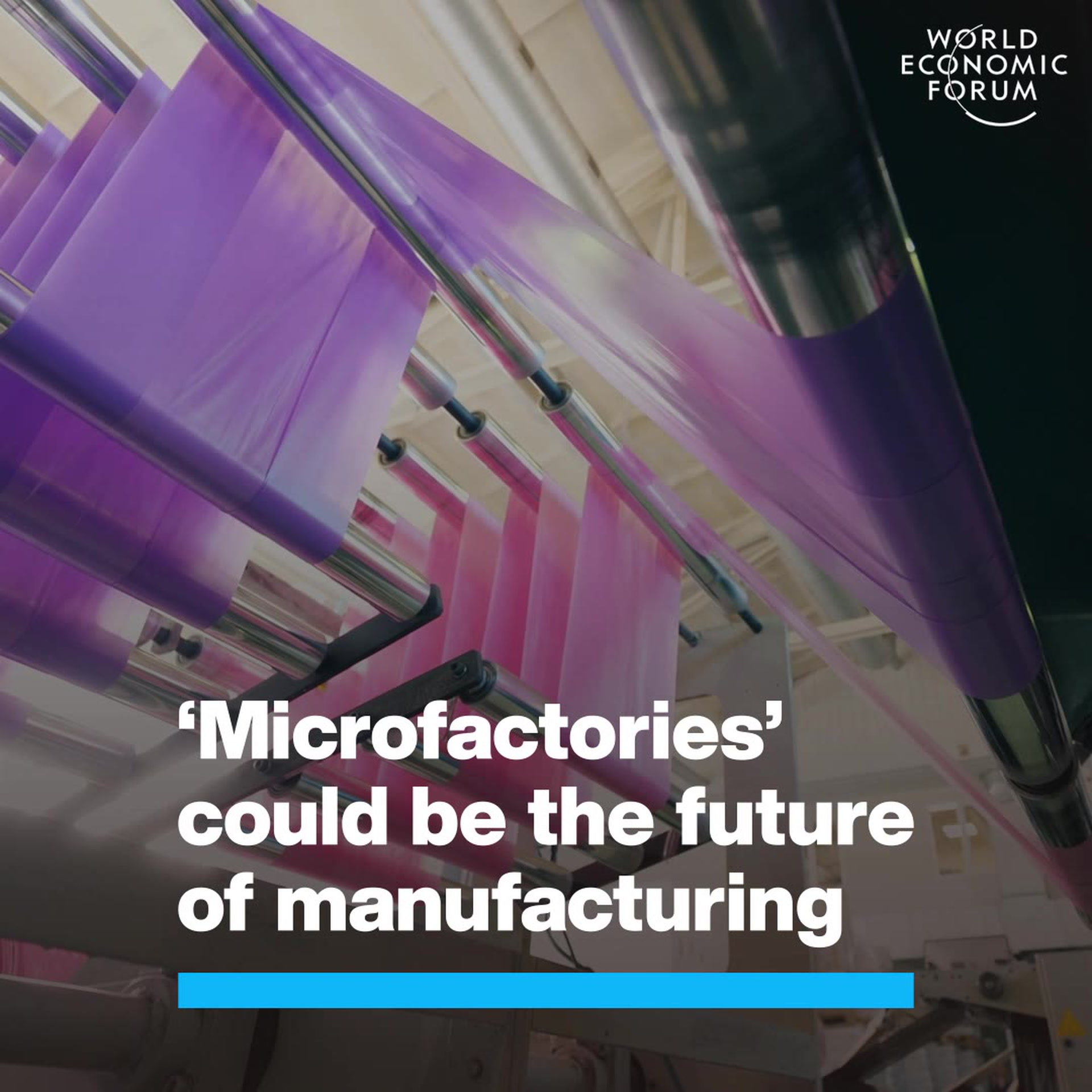Microfactories: why smaller, highly automated factories are the future of manufacturing

Microfactories could be the future of manufacturing. Image: Getty Images/iStockphoto/simonkr

Get involved with our crowdsourced digital platform to deliver impact at scale
Stay up to date:
Artificial Intelligence
- Microfactories are small-to-medium, modular manufacturing facilities that use state of the art technology like AI to optimise their operations.
- They can create significant cost, efficiency and energy savings compared to traditional factories.
- While there are some businesses that have already successfully set up microfactories, some industries still need the right tools and frameworks to help them work out how to make this kind of transformation.
Industry 4.0 – the digital transformation – is revolutionizing the future of manufacturing. Technologies like artificial intelligence (AI) and automation are helping manufacturers boost operational efficiency and achieve a significant lift in productivity – between 15% and 30% in some cases – alongside downtime reductions of as much as 50%.
Technological innovations have also led to the emergence of microfactories. These are smaller manufacturing facilities that use cutting-edge tools and solutions to gain a competitive advantage. They offer new levels of flexibility and scalability that larger, conventional factories struggle to achieve.
Microfactories consume less power and require fewer people to operate than traditional factories because they use new technologies that are more efficient. AI, machine learning, big data and other innovative technologies, helps microfactories with waste elimination, process optimisation and personalisation for their customers.
Microfactories are also modular, which lends itself to high production volumes. Each microfactory can be considered a “cell” of a more extensive production line. These cells can perform various manufacturing tasks, speeding up production times by operating in tandem.
While traditional factories still have plenty to offer in terms of economies of scale and operational efficiency, the modularity of microfactories allows manufacturers to become more efficient. Many are also using AI and the industrial internet of things (IIoT) to boost these efficiencies further.
Enhanced operations and greater sustainability
The inherent benefits of microfactories could prove to be a game changer for manufacturing, but could AI-powered microfactories really replace traditional facilities? Here are four ways in which microfactories are already proving more sustainable than their conventional counterparts, which could help them come to dominate the manufacturing industry in the near future.
1. Increased cost-effectiveness
As the technology available to modern factories continues to change, many manufacturers are investing heavily in innovative tools and solutions. Such investments can quickly add up, especially if the factory needs frequent updates. This will impact production time, product costs and more.
But for microfactories, these costs will be much lower compared to traditional factory lines because only specific cells or components need to be changed. This helps to keep costs under control with faster updates and shorter downtimes.
2. Increased repairability and ease of maintenance
Microfactories are modular and standardised in terms of hardware, software and general infrastructure. This helps them maintain the highest levels of efficiency and makes repairs easy. Compared to larger modern factories with sophisticated technology and customised hardware components, this can result in faster, more efficient factory maintenance.
3. Increased customization and personalization
The advent of IIoT, AI and other advanced technologies means today’s customers can order highly personalised products and services. This can make manufacturing more challenging as producers attempt to adapt their output to suit changing consumer needs. But microfactories can keep up with these demands thanks to their agile and automated systems that facilitate quick changes in production requirements.
4. Increased sustainability and reduced carbon footprint
Microfactories consume less power and resources than conventional factories. Research shows some microfactories use up to 90% less water, up to 50% less chemicals and up to 80% less energy than traditional factories.
Each cell in the production infrastructure can be replicated in bulk as they use about 70% of the same components, resulting in lower overall production, development, and assembly time, energy and emissions. Cells can also be easily swapped out – when compared to the time and resources needed to change an entire production line, this helps reduce waste and increases circularity.
Microfactories in the automotive industry
There are already several high-profile examples of microfactory use around the world.
One successful example – UK-based electric vehicle manufacturer, Arrival – uses decentralised microfactories with highly automated processes. Its advanced robots and software allows the production line to adapt to changes quickly without human intervention.
By using modular hardware, Arrival’s microfactories can be assembled more easily, are more compatible and easier to replace when necessary. It also means Arrival can customise its products to meet customer demands while cutting potential waste.
Perhaps most importantly, its microfactories were built for a fraction of what a conventional factory would cost: roughly US$50 million compared to at least US$1 billion for a traditional factory.
Building the factories of the future
Microfactories certainly look like the factories of the future, but how does a manufacturer know if it should change its entire operational setup in this way?
A transformation of this scale requires a comprehensive overview of processes to ensure the right changes are made. The main challenge today's might manufacturers face, however, is a lack of visibility on which areas of their operations require improvement. This prevents them from having a clear view on whether they are on the right track in their Industry 4.0 digital transformation journeys.
The right benchmarking tools and frameworks can help manufacturers get this information as well as the analytics they will need to this kind of transformation journey successfully. Microfactories should be one of the steps they take to achieve the operational, sustainability and efficiency goals of an Industry 4.0 transformation.
Don't miss any update on this topic
Create a free account and access your personalized content collection with our latest publications and analyses.
License and Republishing
World Economic Forum articles may be republished in accordance with the Creative Commons Attribution-NonCommercial-NoDerivatives 4.0 International Public License, and in accordance with our Terms of Use.
The views expressed in this article are those of the author alone and not the World Economic Forum.
Related topics:
The Agenda Weekly
A weekly update of the most important issues driving the global agenda
You can unsubscribe at any time using the link in our emails. For more details, review our privacy policy.
More on Manufacturing and Value ChainsSee all
Aleksander Ciszek and Devin Culham
April 25, 2024
Andre S. Yoon and Kyoung Yeon Kim
April 23, 2024
Andrea Willige
March 19, 2024






